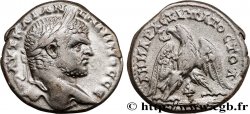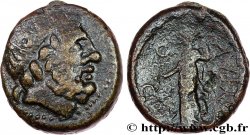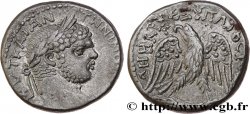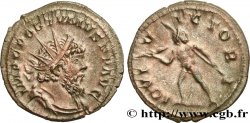bpv_153701 - CARACALLA Tétradrachme syro-phénicien
Nicht verfügbar.
Artikel auf unserem Online-Shop verkauft (2015)
Preis : 180.00 €
Artikel auf unserem Online-Shop verkauft (2015)
Preis : 180.00 €
Type : Tétradrachme syro-phénicien
Datum: 215-217
Name der Münzstätte / Stadt : Antioche, Syrie, Séleucie et Piérie
Metall : Scheidemünze
Durchmesser : 26,00 mm
Stempelstellung : 6 h.
Gewicht : 13,32 g.
Kommentare zum Erhaltungszustand:
Bon centrage et bonne frappe, style caractéristique sans ambiguïté, très faible usure de circulation sur les lauriers et le ventre de l’aigle, patine grise
N° im Nachschlagewerk :
Pedigree :
Cet exemplaire, qui provient de la vente Hirsch 137, 1983 n° 197, est le 0244_009 de la base TSP
Vorderseite
Beschreibung Vorderseite Tête laurée de Caracalla barbu à droite, l’un des rubans de la couronne de laurier passant sur l’épaule.
Legende des Averses AUT. K. M. A. - ANTWNEINOS .SEB.
Übersetzung der Vorderseite (L’empereur césar Marc Aurèle Antonin auguste).
Rückseite
Beschreibung Rückseite Aigle à gauche, ailes dessinées de points écartées, tête et queue à droite, sur une corne d’abondance à gauche entourée de deux points, une étoile à six branches entre les pattes, et une couronne perlée de lauriers dans son bec.
Legende des Reverses : DHMARC EX UPATOSTOD
Übersetzung der Rückseite (Revêtu de la puissance tribunitienne consul pour la quatrième fois).
Kommentare
Le Prieur 244 se caractérise, outre la présence de la corne d’abondance entre les pattes de l’aigle, par le style de l’aigle du revers, aux plumes traitées uniquement en petits points, En réalité un autre détail a été remarqué depuis la parution du Prieur : sur ce type, tous les exemplaires ont la corne d’abondance entourée de deux petits points, détail que l’on ne retrouve pas, ou très indistinctement, sur les autres variantes de la série à la corne d’abondance (Prieur 240 à 245).
À noter, Richard McAlee ne différencie par les styles et regroupe les Prieur 240 , 241, 242, 243 et 244 sous la seule référence 693.
La stabilité de leur position et de la position relative de la corne d’abondance (ici à six branches) fait immédiatement penser à une configuration astronomique ou astrologique.
En effet, nous connaissons déjà deux exemples certains de telles configurations dans les symboles des tétradrachmes.
Tout d’abord, les frappes commémoratives de la fin des travaux des grands temples de Baalbeck, vers 179/180 AD (Prieur 160 à 176 pour les émissions avec la tête de bélier, l’étoile et le foudre (Mercure, Vénus, Jupiter). Les temples étaient dédiés à ces trois divinités, la triade héliopolitaine.
Ensuite, les frappes de Hierapolis (Prieur 1193/1202) avec l’étoile Regulus dans la constellation du Lion.
Notre manque de connaissances en astrologie antique ne nous permet malheureusement pas d’identifier cette position astrologique mais il s’agit, dans la constellation du Capricorne (le mythe prétend que cette constellation est la divinisation de la chèvre Amalthée, nourrice de Jupiter, dont la corne cassée par l’enfant divin se transforma en corne d’abondance) d’une planète ou étoile principale (représentée par le point rayonnant) et deux étoiles secondaires (les deux points). Quoi et pourquoi, nous ne le saurons probablement jamais, de la même manière que l’on ignore pourquoi Hiérapolis utilisa une configuration astronomique comme symbole sur ses tétradrachmes (En réalité, si, et le R.P. Mouterde, auteur de l’interprétation, l’explique par la présence d’un bas-relief identique sur l’autel du grand temple de Jupiter à Hierapolis. Mais pourquoi cette configuration astrale dans ce temple et pourquoi à Hiérapolis, mystère).
Le graveur de ce type est spécifique et ne se retrouve pas ailleurs.
Ces frappes énigmatiques, dites émissions de guerre, sont classées par convenance à Antioche, tant par Bellinger que par Prieur, bien que tous deux considèrent que cette attribution est certainement fausse. La meilleure preuve est la disparition sur ces émissions du Delta Eta dans le champ de revers, spécifique à Antioche et que l’on y retrouve inchangé sous Macrin et Diaduménien. On pense donc à des ateliers militaires itinérants, suivant les légions et frappant à la demande. Ces émissions sont particulièrement intéressantes et mal connues, une recherche des liaisons de coins et une typologie des graveurs pourrait améliorer la connaissance des ateliers militaires à cette période.
Les caractéristiques communes de ces émissions de guerre sont un style peu recherché, des symboles nouveaux et difficiles à attribuer à un atelier particulier, souvent des graveurs répertoriés pour des ateliers bien connus où, en revanche, on ne trouve aucune émission de guerre. Souvent, des frappes de graveurs différents mais de symboles identiques ont été regroupées alors qu’une analyse des liaisons de coins montrera peut-être qu’il s’agit en fait de plusieurs séries nettement séparées.
On remarquera, à propos des émissions de guerre en général, qu’aucune n’est connue à l’effigie de Macrin, le contraire étant la règle pour pratiquement toutes les séries identifiées pour des villes. C’est une preuve supplémentaire que ces séries sont exclusivement liées à la guerre parthique, qui s’interrompt dès la prise du pouvoir par Macrin, et non à une ou des municipalités qui n’auraient pas encore été identifiées.
On note que les sigma sont gravés en C.
Dans la base TSP maintenue par Michel Prieur, cinquante-neuf exemplaires sont maintenant répertoriés dont, en musées, Paris (7), ANS (3), Boston (ex Gush Halav Hoard), Israel State Museum, Yale (2 ex Doura).
The Prior 244 is characterized, in addition to the presence of the horn of plenty between the eagle's legs, by the style of the eagle on the reverse, with feathers treated only in small dots. In reality, another detail has been noticed since the publication of the Prior: on this type, all the examples have the horn of plenty surrounded by two small dots, a detail that is not found, or very indistinctly, on the other variants of the series with the horn of plenty (Prieur 240 to 245)..
Note that Richard McAlee does not differentiate between styles and groups the Prieur 240, 241, 242, 243 and 244 under the single reference 693..
The stability of their position and the relative position of the horn of plenty (here with six branches) immediately suggests an astronomical or astrological configuration.
Indeed, we already know two certain examples of such configurations in the symbols of the tetradrachms.
First of all, the commemorative strikes of the end of the works of the great temples of Baalbeck, around 179/180 AD (Prior 160 to 176 for the issues with the ram's head, the star and the thunderbolt (Mercury, Venus, Jupiter). The temples were dedicated to these three deities, the Heliopolitan triad.
Then, the strikes of Hierapolis (Prior 1193/1202) with the star Regulus in the constellation of Leo.
Our lack of knowledge in ancient astrology unfortunately does not allow us to identify this astrological position but it is, in the constellation of Capricorn (the myth claims that this constellation is the deification of the goat Amalthea, nurse of Jupiter, whose horn broken by the divine child was transformed into a horn of plenty) of a planet or main star (represented by the radiant point) and two secondary stars (the two points). What and why, we will probably never know, just as we do not know why Hierapolis used an astronomical configuration as a symbol on its tetradrachms (Actually, yes, and the R. P. Mouterde, author of the interpretation, explains it by the presence of an identical bas-relief on the altar of the great temple of Jupiter in Hierapolis. But why this astral configuration in this temple and why in Hierapolis, mystery).
This type of engraver is specific and cannot be found elsewhere..
These enigmatic strikes, called war emissions, are classified for convenience in Antioch, both by Bellinger and by Prieur, although both consider that this attribution is certainly false. The best proof is the disappearance on these issues of Delta Eta in the reverse field, specific to Antioch and which we find there unchanged under Macrinus and Diadumenian. We therefore think of itinerant military workshops, following the legions and striking on demand.. These issues are particularly interesting and poorly known; research into die links and a typology of engravers could improve knowledge of military workshops during this period..
The common characteristics of these war issues are an unsophisticated style, new symbols that are difficult to attribute to a particular workshop, and often engravers listed for well-known workshops where, on the other hand, no war issues are found.. Often, strikes by different engravers but with identical symbols have been grouped together, whereas an analysis of the die links will perhaps show that these are in fact several clearly separate series..
It should be noted, with regard to war issues in general, that none are known to bear the image of Macrinus, the opposite being the rule for practically all series identified for cities.. This is further proof that these series are exclusively linked to the Parthian War, which ended as soon as Macrinus took power, and not to one or more municipalities that have not yet been identified..
Note that the sigmas are engraved in C.
In the TSP database maintained by Michel Prieur, fifty-nine examples are now listed, including, in museums, Paris (7), ANS (3), Boston (ex Gush Halav Hoard), Israel State Museum, Yale (2 ex Doura)
À noter, Richard McAlee ne différencie par les styles et regroupe les Prieur 240 , 241, 242, 243 et 244 sous la seule référence 693.
La stabilité de leur position et de la position relative de la corne d’abondance (ici à six branches) fait immédiatement penser à une configuration astronomique ou astrologique.
En effet, nous connaissons déjà deux exemples certains de telles configurations dans les symboles des tétradrachmes.
Tout d’abord, les frappes commémoratives de la fin des travaux des grands temples de Baalbeck, vers 179/180 AD (Prieur 160 à 176 pour les émissions avec la tête de bélier, l’étoile et le foudre (Mercure, Vénus, Jupiter). Les temples étaient dédiés à ces trois divinités, la triade héliopolitaine.
Ensuite, les frappes de Hierapolis (Prieur 1193/1202) avec l’étoile Regulus dans la constellation du Lion.
Notre manque de connaissances en astrologie antique ne nous permet malheureusement pas d’identifier cette position astrologique mais il s’agit, dans la constellation du Capricorne (le mythe prétend que cette constellation est la divinisation de la chèvre Amalthée, nourrice de Jupiter, dont la corne cassée par l’enfant divin se transforma en corne d’abondance) d’une planète ou étoile principale (représentée par le point rayonnant) et deux étoiles secondaires (les deux points). Quoi et pourquoi, nous ne le saurons probablement jamais, de la même manière que l’on ignore pourquoi Hiérapolis utilisa une configuration astronomique comme symbole sur ses tétradrachmes (En réalité, si, et le R.P. Mouterde, auteur de l’interprétation, l’explique par la présence d’un bas-relief identique sur l’autel du grand temple de Jupiter à Hierapolis. Mais pourquoi cette configuration astrale dans ce temple et pourquoi à Hiérapolis, mystère).
Le graveur de ce type est spécifique et ne se retrouve pas ailleurs.
Ces frappes énigmatiques, dites émissions de guerre, sont classées par convenance à Antioche, tant par Bellinger que par Prieur, bien que tous deux considèrent que cette attribution est certainement fausse. La meilleure preuve est la disparition sur ces émissions du Delta Eta dans le champ de revers, spécifique à Antioche et que l’on y retrouve inchangé sous Macrin et Diaduménien. On pense donc à des ateliers militaires itinérants, suivant les légions et frappant à la demande. Ces émissions sont particulièrement intéressantes et mal connues, une recherche des liaisons de coins et une typologie des graveurs pourrait améliorer la connaissance des ateliers militaires à cette période.
Les caractéristiques communes de ces émissions de guerre sont un style peu recherché, des symboles nouveaux et difficiles à attribuer à un atelier particulier, souvent des graveurs répertoriés pour des ateliers bien connus où, en revanche, on ne trouve aucune émission de guerre. Souvent, des frappes de graveurs différents mais de symboles identiques ont été regroupées alors qu’une analyse des liaisons de coins montrera peut-être qu’il s’agit en fait de plusieurs séries nettement séparées.
On remarquera, à propos des émissions de guerre en général, qu’aucune n’est connue à l’effigie de Macrin, le contraire étant la règle pour pratiquement toutes les séries identifiées pour des villes. C’est une preuve supplémentaire que ces séries sont exclusivement liées à la guerre parthique, qui s’interrompt dès la prise du pouvoir par Macrin, et non à une ou des municipalités qui n’auraient pas encore été identifiées.
On note que les sigma sont gravés en C.
Dans la base TSP maintenue par Michel Prieur, cinquante-neuf exemplaires sont maintenant répertoriés dont, en musées, Paris (7), ANS (3), Boston (ex Gush Halav Hoard), Israel State Museum, Yale (2 ex Doura).
The Prior 244 is characterized, in addition to the presence of the horn of plenty between the eagle's legs, by the style of the eagle on the reverse, with feathers treated only in small dots. In reality, another detail has been noticed since the publication of the Prior: on this type, all the examples have the horn of plenty surrounded by two small dots, a detail that is not found, or very indistinctly, on the other variants of the series with the horn of plenty (Prieur 240 to 245)..
Note that Richard McAlee does not differentiate between styles and groups the Prieur 240, 241, 242, 243 and 244 under the single reference 693..
The stability of their position and the relative position of the horn of plenty (here with six branches) immediately suggests an astronomical or astrological configuration.
Indeed, we already know two certain examples of such configurations in the symbols of the tetradrachms.
First of all, the commemorative strikes of the end of the works of the great temples of Baalbeck, around 179/180 AD (Prior 160 to 176 for the issues with the ram's head, the star and the thunderbolt (Mercury, Venus, Jupiter). The temples were dedicated to these three deities, the Heliopolitan triad.
Then, the strikes of Hierapolis (Prior 1193/1202) with the star Regulus in the constellation of Leo.
Our lack of knowledge in ancient astrology unfortunately does not allow us to identify this astrological position but it is, in the constellation of Capricorn (the myth claims that this constellation is the deification of the goat Amalthea, nurse of Jupiter, whose horn broken by the divine child was transformed into a horn of plenty) of a planet or main star (represented by the radiant point) and two secondary stars (the two points). What and why, we will probably never know, just as we do not know why Hierapolis used an astronomical configuration as a symbol on its tetradrachms (Actually, yes, and the R. P. Mouterde, author of the interpretation, explains it by the presence of an identical bas-relief on the altar of the great temple of Jupiter in Hierapolis. But why this astral configuration in this temple and why in Hierapolis, mystery).
This type of engraver is specific and cannot be found elsewhere..
These enigmatic strikes, called war emissions, are classified for convenience in Antioch, both by Bellinger and by Prieur, although both consider that this attribution is certainly false. The best proof is the disappearance on these issues of Delta Eta in the reverse field, specific to Antioch and which we find there unchanged under Macrinus and Diadumenian. We therefore think of itinerant military workshops, following the legions and striking on demand.. These issues are particularly interesting and poorly known; research into die links and a typology of engravers could improve knowledge of military workshops during this period..
The common characteristics of these war issues are an unsophisticated style, new symbols that are difficult to attribute to a particular workshop, and often engravers listed for well-known workshops where, on the other hand, no war issues are found.. Often, strikes by different engravers but with identical symbols have been grouped together, whereas an analysis of the die links will perhaps show that these are in fact several clearly separate series..
It should be noted, with regard to war issues in general, that none are known to bear the image of Macrinus, the opposite being the rule for practically all series identified for cities.. This is further proof that these series are exclusively linked to the Parthian War, which ended as soon as Macrinus took power, and not to one or more municipalities that have not yet been identified..
Note that the sigmas are engraved in C.
In the TSP database maintained by Michel Prieur, fifty-nine examples are now listed, including, in museums, Paris (7), ANS (3), Boston (ex Gush Halav Hoard), Israel State Museum, Yale (2 ex Doura)







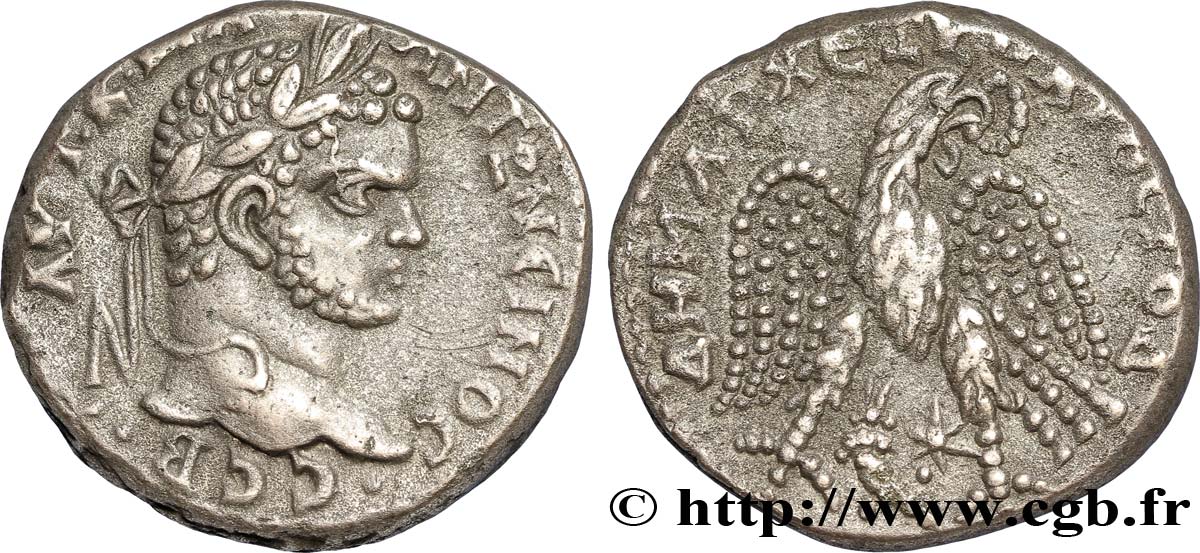
 Berichten über einen Fehler
Berichten über einen Fehler Die Seite drucken
Die Seite drucken Teilen meiner Auswahl
Teilen meiner Auswahl Stellen Sie eine Frage
Stellen Sie eine Frage Einlieferung/Verkauf
Einlieferung/Verkauf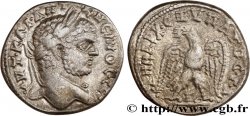
 Details
Details


